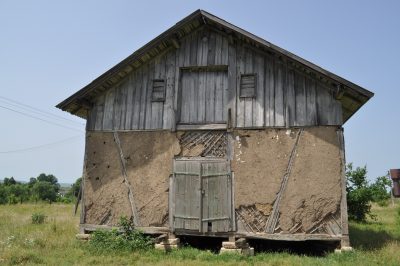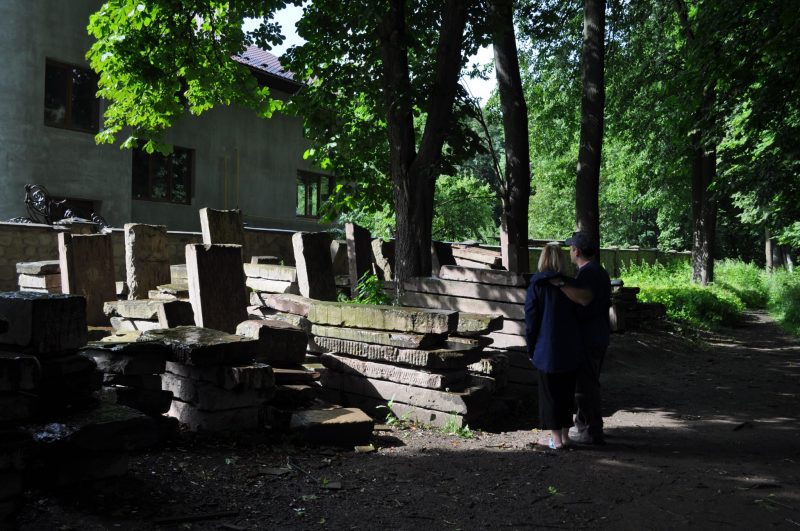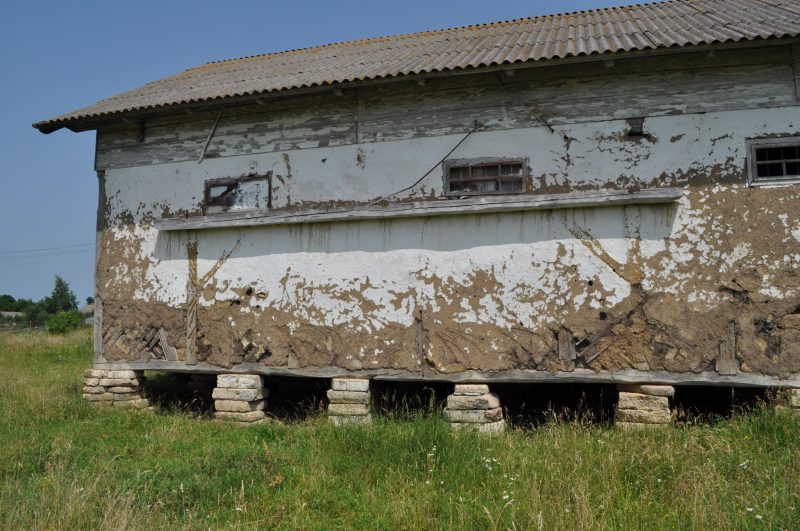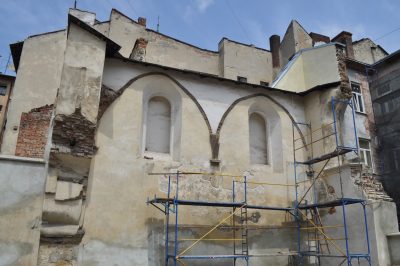Recognition of the Jewish past in Western Ukraine: Changing for the better
15 September 2016 – Jonathan Schaffer

Barn built on stones scavenged from a Jewish cemetery in Ukraine. Photo credit: Jonathan Schaffer
I recently returned from a visit to the former Jewish shtetls of my ancestors now located in present-day Ukraine. This was my second trip in less than a decade, but it felt very different from my initial experience in 2010. When I first visited, I was overwhelmed by the emotional impact of seeing firsthand once flourishing communities relegated to historical oblivion. This time, I was encouraged by the tangible progress I observed in acknowledging the Jewish past, as well as anecdotal evidence of a greater willingness to recognize Ukrainian collaboration in genocide during World War II. Still, it’s hard not to experience some ambivalence as to what represents “enough” in terms of remembering the legacy of millions of murdered innocents, especially since so little has been done to recognize this history in independent Ukraine.
On my first trip in 2010, I visited rural villages with connections to my family’s history and toured the city of Lviv. There, I ventured to the overgrown, garbage-strewn lot that, prior to their destruction in the Holocaust, had been home to the sixteenth-century Golden Rose Synagogue and adjoining Beth Hamidrash. As I carefully navigated my way, the site struck me as a depressing metaphor for the devastation and calculated neglect of a Jewish history that did not fit within a streamlined, Ukrainian nationalist narrative.

Jewish cemetery at Kolomyja. Photo credit: Jonathan Schaffer
On my return this past June, my 70-year old mother accompanied me, bringing her trademark unsentimental perspective. We stopped first at the remaining Jewish cemetery of Kolomyja, which was also the site of mass shootings during World War II. In 2010, there was a lone marker to a nineteenth-century Hasidic rabbi. This time, prominent signage and a display of unearthed headstones rendered as a memorial wall declared the site’s existence as a Jewish cemetery. Hundreds of headstones from other former cemeteries in the area had been repatriated and were stacked neatly in a corner.
I was pleased to see that the cemetery was being partially restored and acknowledged for what it was. Granted, the guard who inquired as to our interest informed us that someone had torched a surviving ohel only months before, and local maps still listed the cemetery as a “park.” The excavation work appeared to be funded by outside Jewish organizations. At the same time, it was noteworthy progress that surely would have required some level of local support.

Barn resting on pillars of headstones. Photo credit: Jonathan Schaffer
Perspective came into play at every turn. In the town of Obertyn, a barn rested on pillars of headstones from the former Jewish cemetery. How disheartening it was to see the Hebrew letters on broken chunks of stone that littered the barn’s perimeter. As my mother noted, though, there was no longer a Jewish cemetery in Obertyn, and there weren’t any Jews living there or coming to visit (at least not regularly). The Ukrainian residents were simple, practical people, she reasoned. Why wouldn’t they put the discarded stones to use? That may be true, I thought, but there were several steps taken that reduced these stones to improvised building materials. We were told that the barn owner was receptive to donating the stones for use in a future memorial. Only time will tell whether this will be the case, but at least it’s now discussed as a possibility.

A babushka sharing stories. Photo credit: Jonathan Schaffer
There were other positive developments along the way. The babushkas in the villages we visited shared, however guardedly, tales of Ukrainian collaboration during the war, as did one of the mayors who spoke compassionately of his town’s Jewish past. And when we visited the former synagogue of Horodenka, which is now used as an athletic facility, the local kids lifting weights in the women’s balcony politely replied to our query and stated that they were well aware of the building’s original purpose.

Remains of the Golden Rose synagogue, 2016. Photo credit: Jonathan Schaffer
Before departing Ukraine, we visited the ruins of the Golden Rose Synagogue in Lviv. I was delighted to see that work was well underway on a memorial plaza to commemorate the former Jewish community. This was the very site which had stood abandoned on my prior visit. The remaining synagogue walls and foundation were also being restored with the Hebrew letters of a mural now visible. Yes, a “Jewish” themed café where patrons negotiate the cost of the meal (charming, isn’t it?) still operated next door, exploiting its proximity to the sacred site, but it was uplifting to witness what had transpired since my prior visit. Here was real progress for all to behold.
Despite these outward signs of improvement, I wrestled throughout my recent trip with how best to reconcile the reality of today with what happened in these places only decades earlier. The two-story buildings of Kolomyja that surrounded us as we enjoyed a leisurely dinner also bore witness to unspeakable horror and cruelty to the town’s Jewish population, much of which was perpetrated and supported by their Ukrainian neighbors. I surely didn’t want to forget what had happened (I was there, after all, to remember), but I also didn’t want to confuse past with present. Perhaps I was never completely at ease with the dynamic, but I chose as best as I could to balance what I was experiencing in the here and now with honoring those who had lived and suffered along those same streets.
Like any place and any people, Ukraine and its citizens are complex and defy generalizations. Much more can be done to honor the rich history of these lands once inhabited by Poles, Jews, and Ukrainians. Denying this past won’t serve modern Ukraine, and more needs to be done to acknowledge former Ukrainian complicity and culpability. At the same time, nothing comes of viewing an entire country as a mass grave and dismissing its citizens as boorish anti-Semites and unworthy partners in building a better future. We must never forget what happened, and we must insist on recognition and respect; but we must do so in the spirit of healing the world, one former shtetl at a time. I was glad to see glimmers of hope on my recent trip that suggest both sentiment and action are moving in a promising direction.
~Jonathan Schaffer is married with two young boys. By profession, he is a managing director at a tech-oriented investor relations firm in NYC. He wishes he asked his grandparents more questions when they were alive.
Editor’s Note: I encountered Jonathan Schaffer’s website, http://www.returntogalicia.com while working on a new exhibit for the Museum of History and Holocaust Education. Although Schaffer does not think of himself as a public historian by profession, I appreciated his nuanced reflections on his observations during two trips to the Galicia region in Eastern Europe, now part of Ukraine. I invited him to write an essay about his personal experience and the challenges of negotiating history and memory in a place with a marked lack of continuity with the past of its former Jewish minority. Public historians should consider his reflections as they plan projects to commemorate forgotten histories in communities around the world.
~ Adina Langer




The new “Space of Synagogues” memorial in L’viv (for which I was on the design competition jury in 2010) is indeed an important step. It is believed to mark the first time in Ukraine that a memorial commemorating Jews was initiated by city authorities. I published an essay about its significance by the photographer and writer Jason Francisco on the Jewish Heritage Europe web site I direct — http://www.jewish-heritage-europe.eu/have-your-say/a-new-day-for-the-golden-rose-in-lviv
There Space of Synagogues itself has a good web site describing the complexity of the project. http://jewish.lviv.travel/en_US/
Jonathan is carrying out the work of memory, noting and remarking on the progress of preservation in Western Ukraine, while still acutely aware of the stories, the events, and the people that remain forgotten. We at Yahad-In Unum are grateful that our work was one of Jonathan’s inspirations. He shows here that preservation and remembrance are not merely the work or responsibility of a nation or an organization; indeed, they can begin with a single individual.